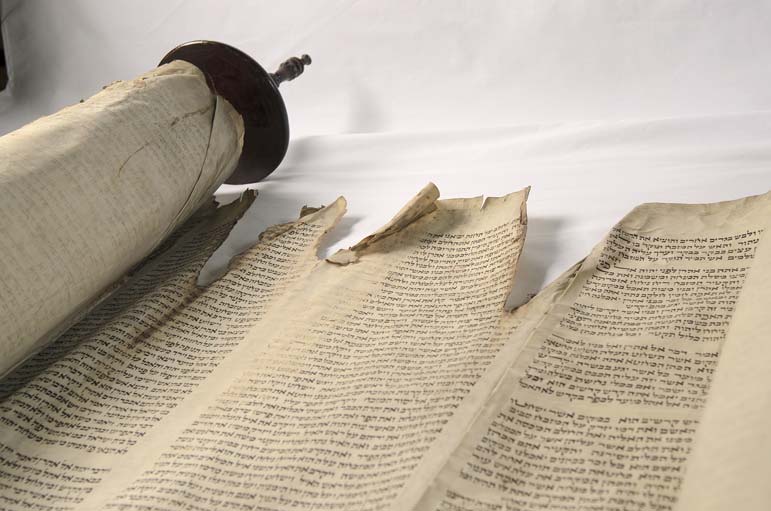 A Torah burned by British troops in the Revolutionary War is part of "Religion in Early America."
A Torah burned by British troops in the Revolutionary War is part of "Religion in Early America."
WASHINGTON - Closed for renovations since 2012, the second floor of the National Museum of American History's west wing will reopen Wednesday with a renewed purpose: to tell the story of American democracy and encourage people to participate.
Formerly the home of a hodgepodge of exhibits, including Julia Child's kitchen and "First Ladies Fashions," the renewed 30,000-square-foot space now seems like a cohesive, three-dimensional civics textbook - it even has a textbook-worthy name: "The Nation We Build Together."
There are four new exhibits and an old one that has been updated. The first new display that most visitors will encounter is "American Democracy: A Great Leap of Faith." With such objects as the desk on which Thomas Jefferson drafted the Declaration of Independence, a pair of shoes worn by a protester in the 1965 march from Selma to Montgomery, Alabama, and the red shawl worn by Susan B. Anthony, the exhibit traces our political system's evolution from one where only white, property-owning men could vote to today's more-or-less universal suffrage.
Another new exhibit, "Many Voices, One Nation," looks at diversity in America and how different groups have cooperated or clashed over the course of the country's history. It includes many objects showing varied cultures that took root here, including a pair of moccasins made by an early European explorer and an intricate table of inlaid wood featuring American plants and animals made by a German immigrant in the mid-1800s.
"This is a 500-year journey that people will travel with us on to see how strangers become neighbors and how they have worked together to shape the community of the nation," exhibit curator Nancy Davis says.
In the center of this renovated area, visitors will find the third new display, "Religion in Early America." Unlike the others, this exhibit is temporary - it will close June 3, 2018 - and it delves into an area of American history that's often missed in social studies classes, curator Peter Manseau says. "You walk into this show and you will learn immediately that religion in America is much more diverse than most people realize," he says.
Through such artifacts as a Torah burned by British troops in the Revolutionary War and an Islamic religious text written by an enslaved African in Georgia, the exhibit shows that people from many faiths have lived here since the nation's earliest days.
"The practical implication of that diversity is that everyone had to learn to get along, and that leads to the disestablishment of any single church and leads to what we now think of as religious freedom," Manseau says.
The old, updated exhibit is "Within These Walls," which opened in 2001 and features a house that was moved, brick by brick, from Ipswich, Massachusetts. The exhibit, which tells the story of the various people who lived in the home from the 1760s to 1963, contains one major new addition: the story of an enslaved man named Chance, who was one of the home's earliest residents.
The exhibit used to contain just one trace of Chance - a museum placard with the headline "Chance Is a Mystery" that explained how enslaved people are often missing from historical records. Now, thanks to new research by exhibit co-curator Shelley Nickles and others, the house includes placards explaining that Chance was 14 when he was leased to the home's owners during the Revolutionary War and that he eventually returned to his birthplace of Marblehead, Mass., as a free man.
"Today Chance has a full name - Chance Bradstreet - and we know that he worked preserving cod on the waterfront," Nickles says.
At the end of the renovated portion is an exhibit area with lots of seating and a fantastic view of the Mall. This is not just a space for people to rest, however - it's "Unity Square," where museum facilitators will encourage visitors to play games and think about what they've learned from the exhibits.
The only historical artifact in "Unity Square" is the "whites only" lunch counter where, in 1960, four black college students in Greensboro, North Carolina, staged a peaceful sit-in that ignited a nationwide desegregation movement. The counter, which was moved from another part of the museum, now features a mirror that transforms into a movie screen every 20 minutes or so and plays a film about the protests.
"This space is really about being inspired by people in the past who have participated in our democracy and changed America and even changed the world," says "Unity Square" project director Megan Smith. "We hope this is where people will take what they have learned on the entire floor and reflect on their place in shaping America's future."
---
IF YOU GO:
"The Nation We Build Together."
National Museum of American History, 1400 Constitution Ave. NW. 202-633-1000. americanhistory.si.edu
Admission: Free.


 Contact The Editor
Contact The Editor
 Articles By This Author
Articles By This Author